
My birthplace is Sydney, Australia, and I've lived all my life in this city. As an only child, growing up in the days before television became widespread, I learned to keep myself entertained pretty well. Sometime around 1960, when I was five, my grandparents upgraded their very old black telephone to a newer model. The old one was given to me to play with. In my case, playing involved a screwdriver and completely disassembling the old phone to try and understand how it worked. I recall I'd previously taken an old clock apart, and managed to get it back together and working. Which was fun, but there wasn't anything mysterious about the springs, gears and balance wheel in the clock. The only challenge was taking the balance wheel with its delicate spring out, then getting it back together without damaging the spring.
The phone though, to a small child with no knowledge of electronics, was a mighty interesting thing. By disassembled, I mean completely — down to levering open the microphone and earpiece, finding the microphone's carbon contacts and pinch of loose carbon granules. I could see how that worked - when sound hit the diaphram, it must compress the granules and make it easier for the electricity to pass through. Which is more or less correct, and not bad for a five year old. The earphone contained a magnet and coil of wire, so I worked out that there must be some way that electricity and coils interacted with magnets. You have to remember, I was a small child, with nothing in the way of test equipment, power supplies, wire, solder, etc. I couldn't even read yet. No one in my family had any knowledge of electrical things at all, and there wasn't anyone else I could ask.
Still, the interest was sparked. My parents were relatively poor, so mostly all I had to play with was thrown out things I found. Then sometime around 8 or 9 years old I was given one of the Philips EE kits. (pics from the web)

Around that time I received a small cheap moving coil multimeter, and a 'Pico' soldering iron.

That multimeter is long gone. I got many years of use out of it, but eventually accidentally destroyed it. The photo is from the web. It's the exact same model, but a different re-branding. The soldering iron is my original, that still works. It has a new tip, but at the moment the power transformer is mislaid.
After that my electronics hobby progressed fairly well, apart from always having very little money and not knowing anyone else with similar interests. The resources I had access to were Electronics Australia magazine, and from 1971 onwards also Electronics Today International. The only electronics component shops I knew of were in the city, which meant a longish train trip when I could afford to buy anything. However there was a local rubbish dump in easy bicycle distance, and in those days the Safety Nazis hadn't yet taken over. So if a teenager wanted to scrounge old radios and TVs and stuff from the tip, there was nothing stopping him.
Skipping forward to 1976, I was 21 and finally earning some money. I bought two things - an old car, and a Telequipment D66 oscilloscope for $783 incl tax. This scope was much more fun than the car. The car was totalled years later, but I still have the scope and it still works. No thanks to Telequipment, whose transformer design was faulty (insufficient HV insulation.) After two shorted in succession I ended up having a replacement custom built by a local transformer maker.
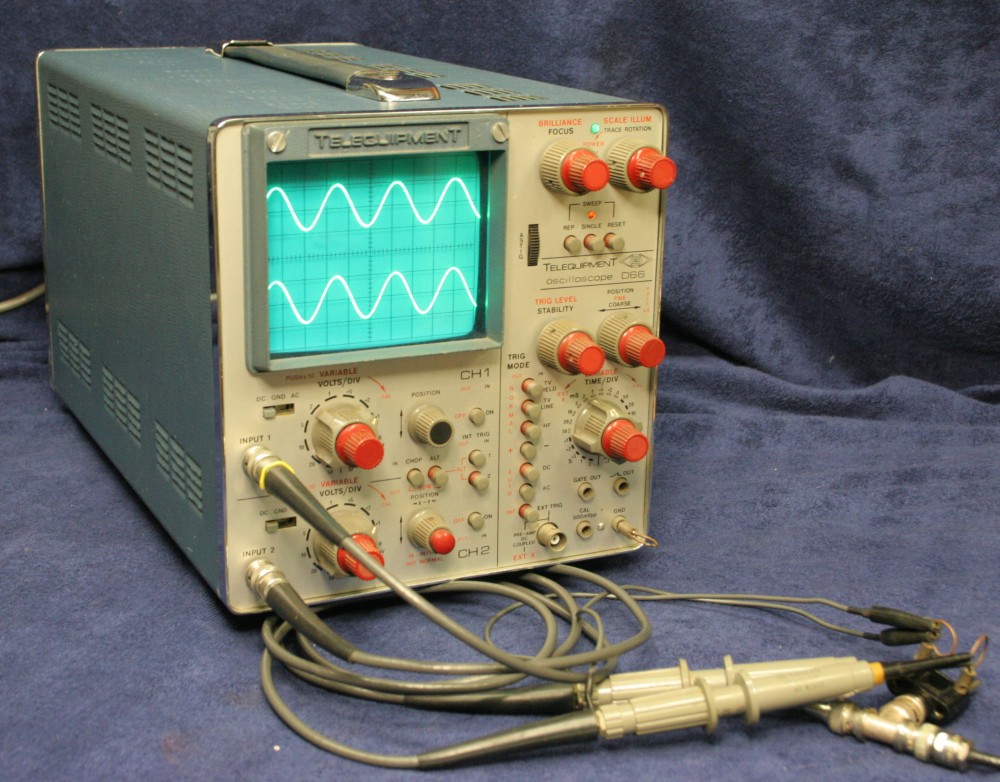
Then I moved out of home, and that was the end of significant disposable income. By then I'd built myself some power supplies, signal generators and such, so I had the basic test equipment set. Which was fortunate since for the next decade I was just breaking even. I nearly caught the wave of the early home computer boom, with a nice product for the Apple II. But blew that one by making a particularly naive (ie stupid) business decision in agreeing to an exclusive distributorship, via a company that then did nothing with it. Designed some great gear for professional video editing suites using cheap home computers, plus a VITS time code video inserter that worked better than Sony's. But ultimately couldn't stand my business partner. Spent some time writing video poker games (for people that were making millions from operating the games), but was too naive to negotiate a percentage. That was probably the poorest I've ever been, and the most depressing. People I worked for getting stinking rich off the code I wrote, while I often had trouble paying for food and rent. Oh well, at least I'm alive, and they are now mostly not.
In 1987, aged 32, I married. Which meant it was time to stop farting around with losing projects, and get a muggles job. Much more income suddenly, but that didn't mean I got to spend anything more on things I wanted. So I still had only my old scope and other gear I'd built myself.
This lack of test gear may be hard to understand, for people living in America, Britain, Germany, etc where there is a large amount of cheap surplus test gear and a thriving second hand market. The problem is, Australia is different. Back then and still today, there's far, far less second hand equipment available, thus not much in the way of established sales channels, and what little there is tends to be high priced. There are a number of causes:
Now remember, I'm talking about the 1970s, 80s and early 90s. There wasn't any Internet, no Ebay, Gumtree, etc. There was a printed thing called Trading Post for a while, which was for anybody to place small cheap adverts, kind of like Ebay but via a weekly newspaper format, and without the ebay-paypal fascist control-freak-ism. However the people who ran the Trading Post had no idea there was any demand for a surplus science/electronics category. So there wasn't one. Hence no demand, in an unfortunate self-defeating loop.
It was sad — they came so close. Once they advertised for submissions of ideas for new categories, and I submitted 'Space Junk', and explained what that meant. They liked the idea, but then didn't implement it. Which was incredibly ironic, since while I was talking with them about the idea they mentioned that they had recently upgraded their typesetting system, and had no clue what to do with the old gear, did I want it? So I got a free trailer-load of interesting old computer gear. Would have rather seen the Space Junk category implemented though. They never said why they didn't do it.
Leaping forward again, to 1993. I was working for AWA Wagering in Nth Ryde, writing C and 6800/6809/68000 assembler code for racetrack betting machines and huge race result display signs. The building where I worked was just down the road from the Hewlett Packard building. I still didn't have much electronics test gear other than my old faithfuls (apart from a better scope and a HP logic analyzer), and by this time (age 38) that lack was really starting to hurt. Of course I didn't know things were going to change dramatically in a few years as the net and then ebay broke down the barriers to personal international buying. I also at that time wasn't yet fully aware of the corporate deliberate policy of surplus equipment destruction.
So one day I dropped in at HP's reception, and asked if they might have any second hand pieces of test gear they'd sell for affordable prices. I don't know why I imagined the answer could ever be 'yes'.
Anyway, I got introduced to a HP service engineer. He made a point of explaining to me in the foyer in front of others that HP did not sell anything that didn't meet HP standards (and HP prices.) But then as he walked me out, once out of earshot of others he told me to meet him in the carpark the next day, as he had a few bits of gear he'd personally sell.
Me being the eternal sucker, I agreed.
Next day, he showed up with a couple of old HP instruments in his car boot. And I mean ooooold. He had a HP 608C VHF signal generator, and a HP 606A signal generator. Like these (pics from web):
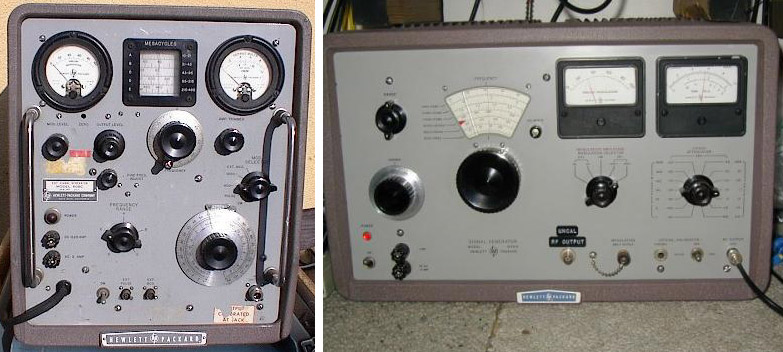
These are valve (vaccum tube) instruments, but I've always had a soft spot for valves, since a lot of my childhood electrical adventures were with old valve radios and TVs. Also my excuse for why I didn't decline is that I was very much in awe of Hewlett Packard equipment in general, that the 608C in particular is a very beautiful and impressive looking piece of gear, and that I really was 'test equipment starved'. Plus my God, this thing goes up to 480 Megacycles! (That's what it says on the front panel.) Somehow Megacycles just sounds more impressive than MHz, don't you see? In any case it was far higher than anything else I had any hope of obtaining (I thought.) I wasn't even aware of any existing sources of second hand test gear. Those of you who have grown up with the Internet must find it hard to comprehend the kind of information isolation that existed before the Net.
Very foolishly I paid the stupidly high price he asked. I forget what it was, maybe $300? $500?
Now today, that might be an OK price (in Australia.) Those things are much further into rare antique zone now, and the currency is devalued a lot. But then, in 1993, it was crazy, I think. Only myself to blame.
This is were the story gets sad. Violins please.
These were the first pieces of significant, professional test gear I'd ever owned. They were both pretty dirty, especially the 608C, which had some corrosion on the front panel and dials. I decided I'd attempt to clean it up, try to get it new looking again. But of course, this was also to be my first attempt at restoring old test gear.
I didn't yet have manuals (no ebay!) but I could start on restoration of the mechanical parts. The first of which was the front panel. Taking notes, I disassembled it to the point where I had the front panel plate separated. It's a flat plate of aluminium, about 4mm thick, holes for meters and knobs, painted with gray enamel, and all the legends are engraved into the metal and filled with black paint. But some of the gray paint was flaking, with surface corrosion of the underlying metal. I figured the only thing to do was to sand back the entire face to clean metal.
That went OK, and the lettering was still fine. It looked nice actually, in shiny aluminium. Ah, but now I realised I'd dug a hole for myself. Because what next? I can spray paint it gray again, but that will fill the lettering with gray too. How to end up with the same effect as it had originally? I assume HP had sprayed it gray, then engraved the lettering and filled it with black. But there's no way I can think of to spray it gray, then neatly clean out the original engraved characters.
So the project got shelved. Literally, up on top of a shelf, while life swirled on. Two kids, job changes, part time courses, a major owner-building project, marriage difficulties, a best friend died, my father died, another friend died, new house construction, moving, garden landscaping, adventures with my Urbex friends, overseas travel, I acquired a new 'major life ambition'... and during all that the Internet happened. Not to mention a huge paradigm shift when Sept 2001 and subsequent revelations demonstrated the world's major governments are in the hands of psychopaths and bankers (far more than I already knew.)
Additionally due to ebay and some other windfalls, I suddenly had plenty of test gear, more and better than I'd ever imagined I could own. And none of it vacuum tube based.
The disassembled and wedged HP 608C refurbishing project stayed shelved. The only thing changing was which shelf, in which building. Eventually, sometime around 2005 I got fed up with that waste of space, stripped the carcass down for some useful parts, and recycled the bulky frame. The diecast main oscillator unit was too cool to just scrap, so that hung around for some more years till I gave it away to a radio ham enthusiast in 2013. I think the remnant of the thick front panel is still around somewhere in one of the piles of aluminium plate stock, since I often need scraps of aluminium.
I'd never touched the 606A. Never even powered it up, since for one thing its mains cord had been rubber, gone brittle and been cut off by someone. Also the glass of one of the meters had been broken originally. So it needed work. But I really didn't feel like putting work into it, after the 608C mistake. Also it was all still in one piece, so not so much of a nuisance to just leave sitting around. I had at some point acquired manuals for both the 606A and 608C though.
Recently while rummaging among boxes in the storage loft, I came across the 606A again. It had been somewhat buried, and I'd forgotten about it. Immediate thought: "Why do I still have this? There are probably people who'd want it, but I'm not one of them. There's no way I have room in my work area for this, and here it's just wasting space. Better to sell it. Err... and I suppose that means I should see if it works.
This is it, after some cleaning and repair:
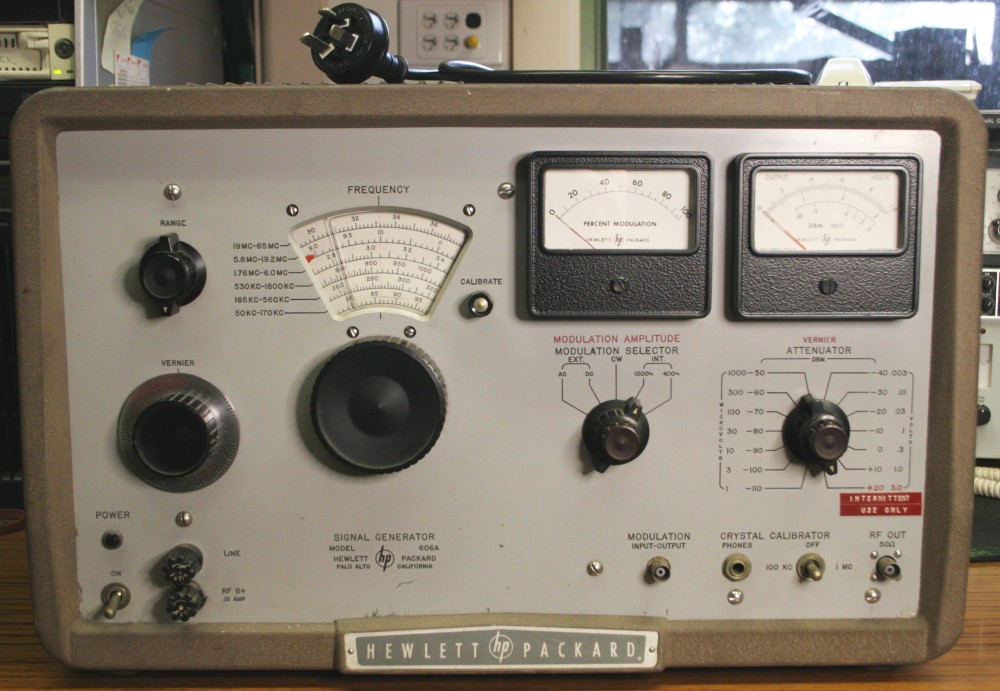
That was something I embarked on with some trepidation. With the example of what happened to the 608C (utter failure) and more recently the HP 1000 minicomputer 'restoration to sell it' (I became too attached, and decided to keep it), I wondered which way this one would go. But seriously, it's TOO BIG for my needs. Also I'm much better at restoring electronics now.
First step was to fix the broken-glass meter. Or rather... both meters, since the paint is showing spot corrosion on both. Immediately I hit the first snag. The modulation meter has one of its retaining nuts in an almost impossible to reach spot. After some futile struggles I ended up sacrificing an old 5/16" ring spanner, cutting and grinding it down to make 'mini-spanner' here:
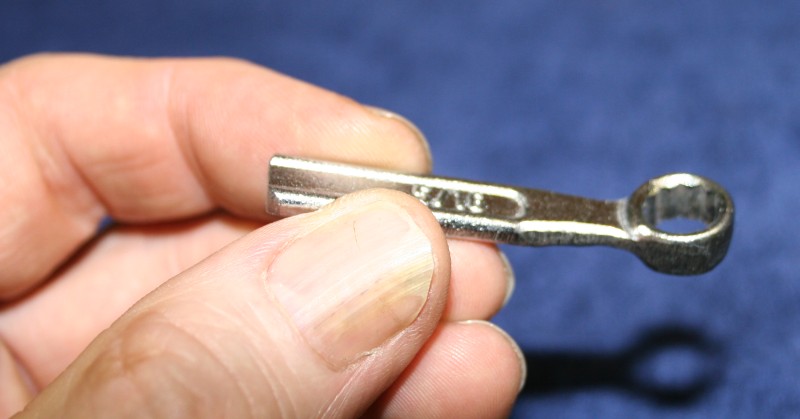
(Yeah, my left thumbnail is odd, due to crushing the end of my thumb under a big wooden block when I was five. Fluke accident, and funny since the result is I have ten fingers but eleven fingernails. Left thumbnail has two, stacked.)
With the mini-spanner it was easy to remove the two metal meter fascias to sand them back to clean metal then spray them again, cut a new pane of glass for the broken one, then reassemble both. The only hiccup was discovering that the meter with the broken glass had acquired a couple of microscopic magnetic particles caught in the magnetic gap of the meter movement. An interesting problem. You can't use compressed air since that would wreck the fine tension spring. The solution is a slivver of thin but stiff plastic, with a few square mm of double sided sticky tape stuck firmly onto the end, then the backing peeled off so the exposed sticky side is fresh. The tacky adhesion is much stronger than the magnetic force on tiny metal splinters.
Then it turned out that the bearings of the shaft that turns the tuning turret had become utterly seized. They'd turned the first couple of times I tried the mechanism, but then locked. So badly I thought the bearings must have metal spalled, and it was going to be another writeoff. Even pushing directly on the teeth of both turrets by hand I couldn't budge it at all.
Hmmm.... Well it's either going to move or break. I gave all the bearings a squirt of WD40, left it a day then put leather gloves on (those teeth hurt your hands!) and just laid into it. It moved. Reluctantly, but it kept going. And got easier as I worked it back and forth. After half an hour of working more WD40 into the bearings it was fine again. I guess it was just old grease gone solid.
Next was replacing the mains cord, which was easy.
I'd also noticed the output attenuator had mechanical problems. The cams don't bear directly on the plungers, but rather press them via a comb of thin spring stainless springs. And the springs are all mangled. To fix this the attenuator block would have to be taken out and disassembled. I'm not going to do this, whoever wants to do a full restore of the unit gets to do it. All I want to know is does it work?
Silly me I think, of course it doesn't. It hasn't been powered up for at least 20 years. How could it possibly work? What I meant to say was, how badly dysfunctional is it?
None of the valves' Barium getter films on the inside of the glass are milky looking (which means oxidized), so at least they are all still vacuum tight. For what that's worth.
After setting it up on a variac and gradually ramping up the mains to 240VAC, it's a pleasant surprise to find no bangs or stinks.
I hadn't even bothered to connect the 606A up to the scope at that point, because I was expecting to be diving right into diagnostic mode, starting with something like 'why isn't the power supply working?'
Another relief — every valve filament is glowing. Huh. Well I guess I should check for output signal now, just in case. I connect the coax, and nope... noth... oh wait, turn the attenuator for maximum output... nope, still noth... uh, but, better wiggle the knob a bit, since there are those busted springs in the attenuator.
Annnnnd... ha ha, how about that! It's working!

The carrier is spot on frequency, stable, and modulation works too. Variable output level works. Multiple ranges work, and it maintains output level well across ranges. Although, the modulation knob and/or meter seems to be off somewhat. More things for the future owner to do.
The remaining photos are of the interior, and the unit assembled.
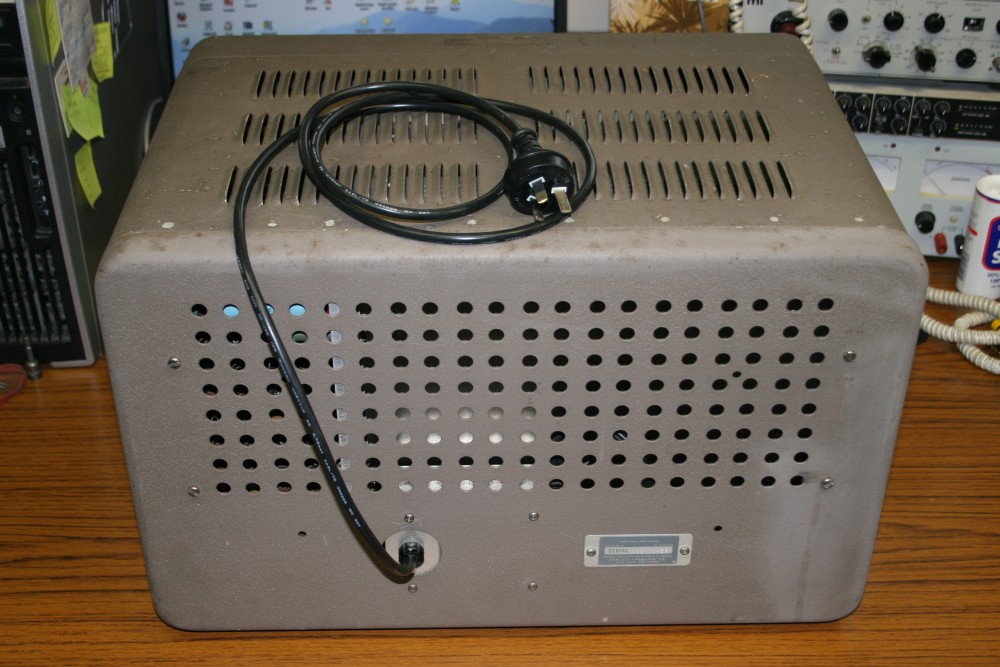
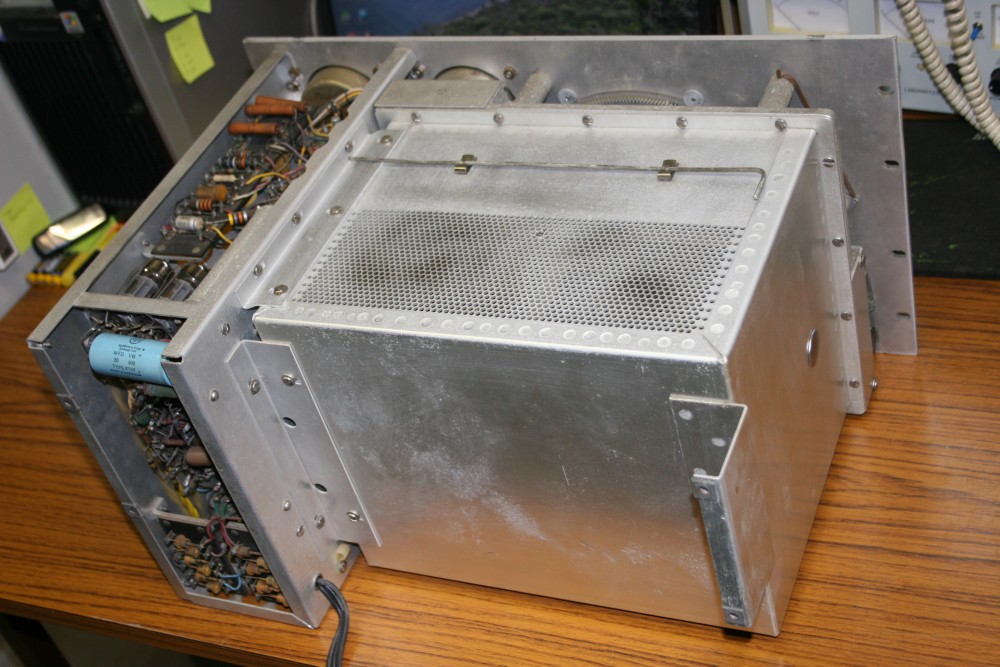
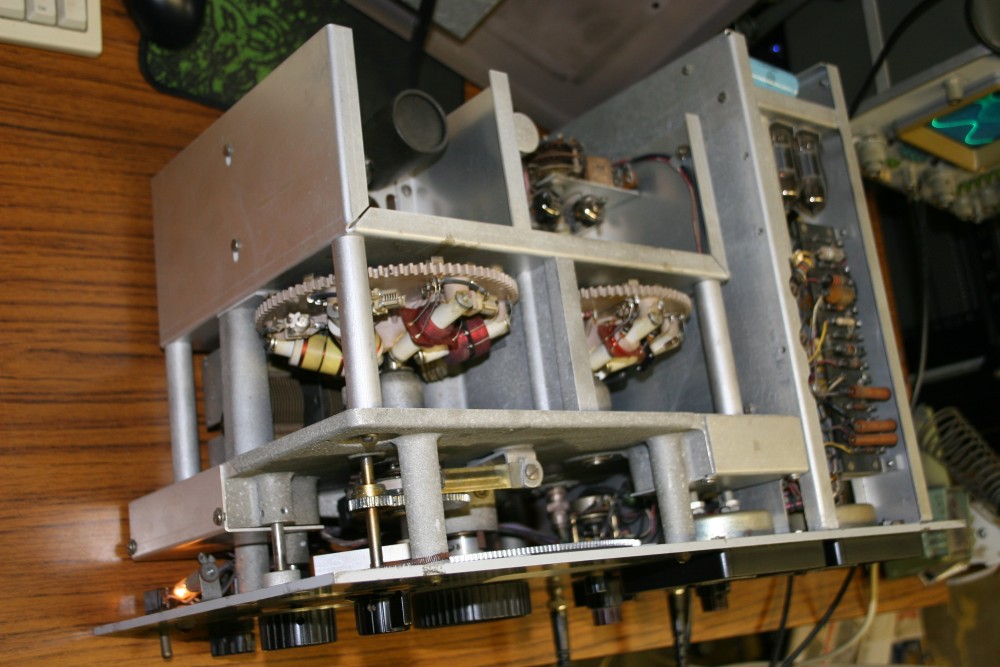

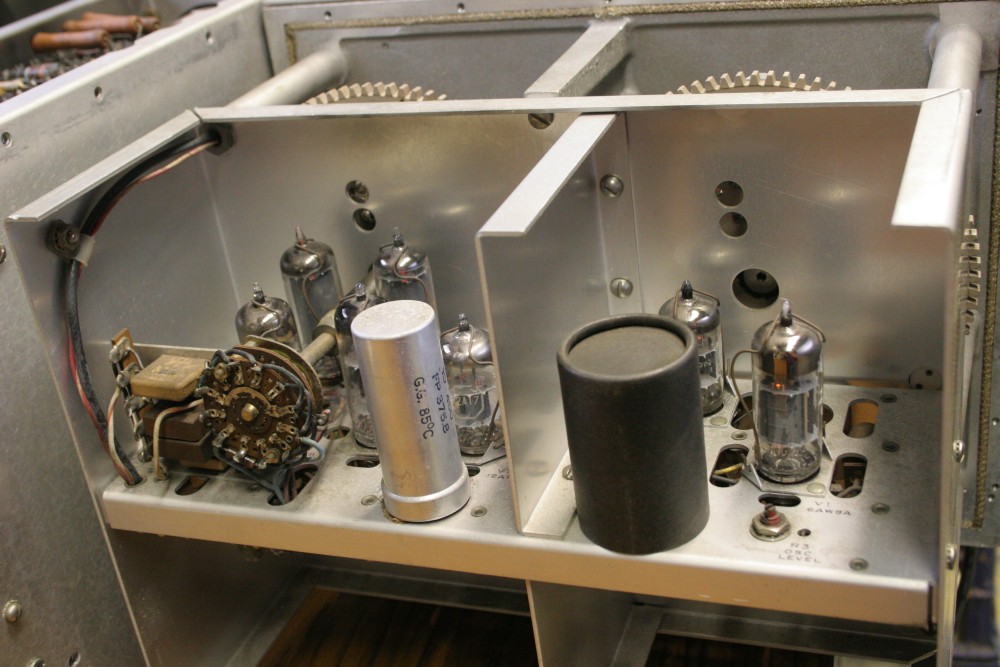
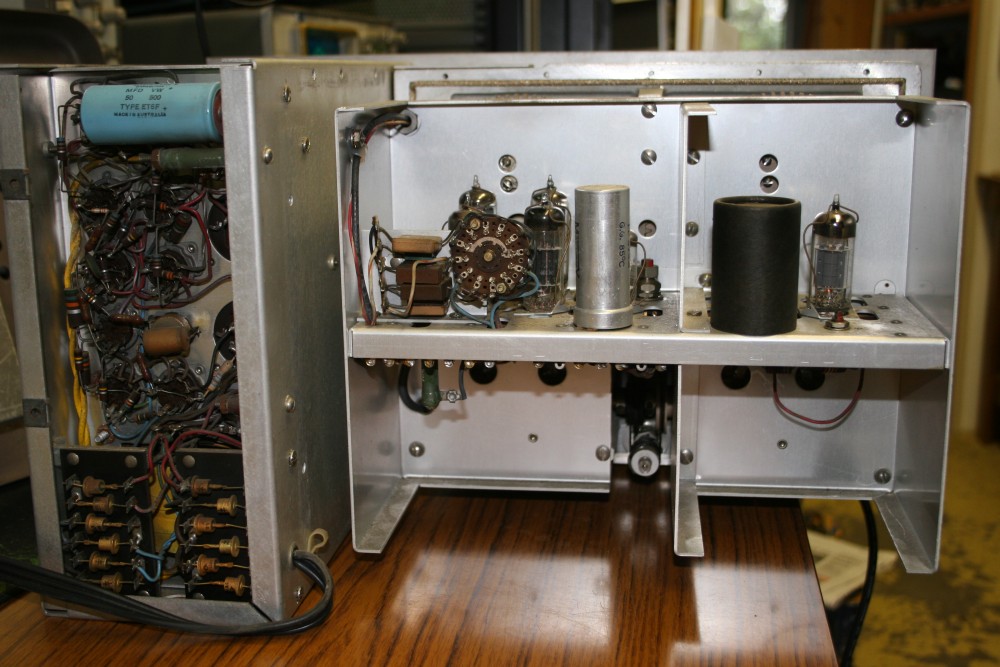
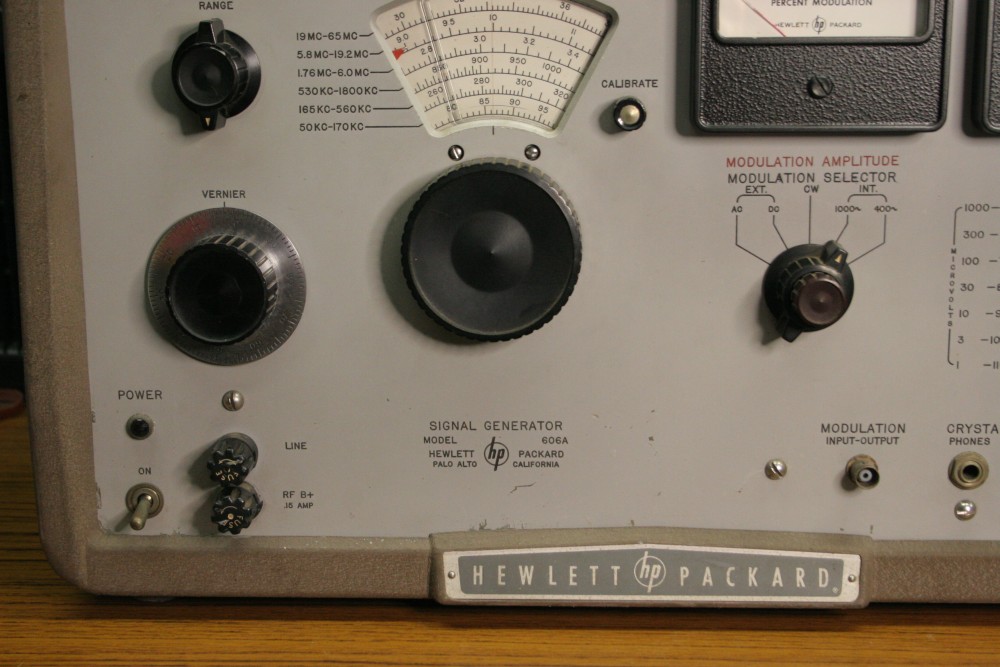
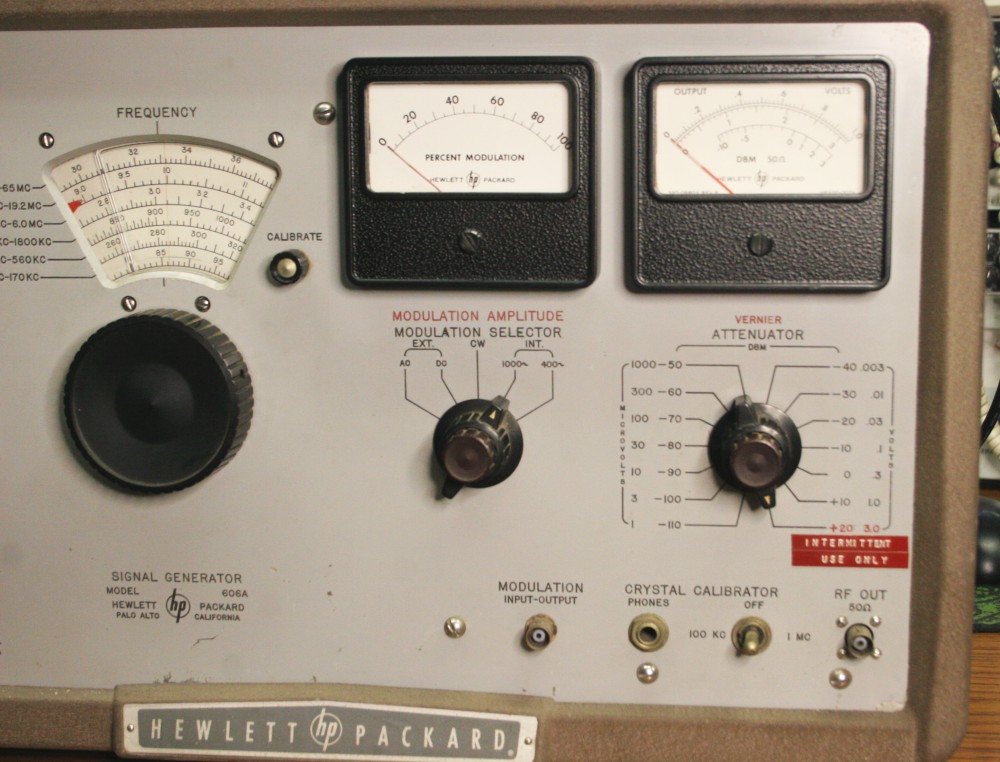
As expected, the PDF version of the 606A manual I found on the net is fairly terrible. Why do so many people fail to deal adequately with scanning and especially screened photographic images? The 608C manual online is better but still isn't as good as it should be for such a historic instrument. So that's two more manuals to scan.
Online descriptions of the 606A mention that it has an exceptionally high phase stability, which makes it a prefered instrument for some kinds of measurement even today. Nice to see that it's not entirely obsolete.